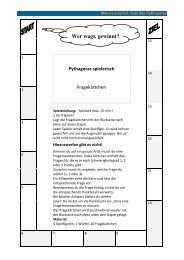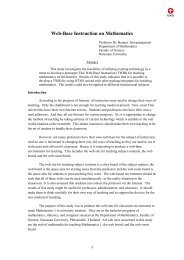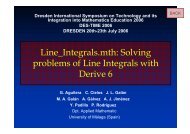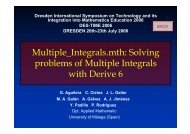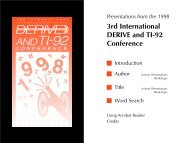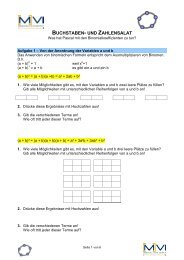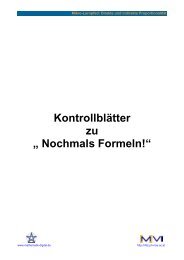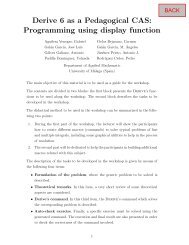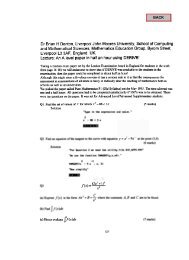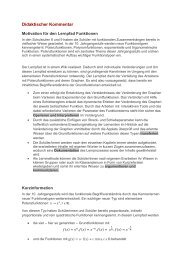The Algebraic Calculator as a Pedagogical Tool for Teaching ...
The Algebraic Calculator as a Pedagogical Tool for Teaching ...
The Algebraic Calculator as a Pedagogical Tool for Teaching ...
You also want an ePaper? Increase the reach of your titles
YUMPU automatically turns print PDFs into web optimized ePapers that Google loves.
Fourth International Derive TI-89/92 Conference<br />
<strong>The</strong> goal of intellectual sports are intellectual fitness and health <strong>as</strong> h<strong>as</strong> been described in detail earlier.<br />
It goes without saying that technology should only be a training tool (“mathematical home trainer”)<br />
and must not be used when testing these abilities.<br />
<strong>The</strong> goal of problem solving is the ability of using given tools <strong>for</strong> solving given problems. It goes<br />
without saying that the use of technology should be highly welcome here.<br />
Once again I draw a parallel using the initial comparison of mathematics with moving/transportation.<br />
Problem solving compares with an actual desire of moving from A to B (or transporting something<br />
from A to B). Only the reaching of B counts. It is less important (maybe even unimportant) how we<br />
got there. Intellectual sports compares with a jogger who runs along a track in order to gain physical<br />
fitness. Only the jogging counts. It is unimportant where the track is or where it leads to. Transferred<br />
to mathematics this means the following: In problem solving only the result counts. It is irrelevant<br />
how the calculations were per<strong>for</strong>med. In intellectual sports only the per<strong>for</strong>ming of the calculation<br />
counts, while the result is unimportant.<br />
d) Assessment<br />
<strong>The</strong> above yields a very simple rule <strong>for</strong> <strong>as</strong>sessment: When <strong>as</strong>sessing intellectual fitness, no tool is<br />
allowed, not even a simple four-function calculator. When <strong>as</strong>sessing problem solving, all tools are<br />
allowed (better: solicited), in particular graphic or algebraic calculators. In c<strong>as</strong>e this splitting is not<br />
manageable within an exam, one should <strong>as</strong>sess the two disciplines at different times. It is obvious to<br />
draw a parallel with ice-skating: Intellectual sports compare with the compulsory exercise, in which<br />
the athlete demonstrates the m<strong>as</strong>tery of the b<strong>as</strong>ic techniques. Problem solving compares with the<br />
voluntary exercise (freestyle), in which the athlete demonstrates the ability to combine the b<strong>as</strong>ic<br />
techniques into a nice choreography. <strong>The</strong> total score depends on the scores of both the compulsory<br />
and the voluntary part.<br />
*<br />
In the end technology should play a secondary role in both disciplines. In intellectual sports the goal<br />
is a per<strong>for</strong>mance with a minimum of tools. In problem solving the goal is to learn all those skills and<br />
abilities that are needed <strong>for</strong> problem solving and that are not supported by any technology. A good<br />
mathematics education will use a calculator or computer like language education uses dictionaries.<br />
Concluding remarks<br />
William Shakespeare once said: “Nothing is either good or bad – only thinking makes it so.” Looking<br />
at technology <strong>for</strong> (mathematics) teaching one may change this into: “<strong>Calculator</strong>s and computers are<br />
neither good nor bad teaching tools – only using makes them so.” When driving a car, the most<br />
important is the driver – the car is secondary. Similarly, when teaching with technology the most<br />
important is the teacher – technology comes second. This is another plea <strong>for</strong> strengthening teacher<br />
preservice and inservice training.<br />
In Austria in 1991 all general high schools (Gymn<strong>as</strong>ien) and technical high schools (Höhere<br />
Technische Lehranstalten) were equipped with the DERIVE computer algebra system. In the sequel a<br />
research project w<strong>as</strong> conducted which became known <strong>as</strong> the “Austrian DERIVE Project”. <strong>The</strong> project<br />
involved 800 students who were taught regular mathematics with DERIVE. <strong>The</strong> results were<br />
Kutzler: <strong>The</strong> <strong>Algebraic</strong> <strong>Calculator</strong> <strong>as</strong> a <strong>Pedagogical</strong> <strong>Tool</strong> <strong>for</strong> <strong>Teaching</strong> Mathematics Page 14





